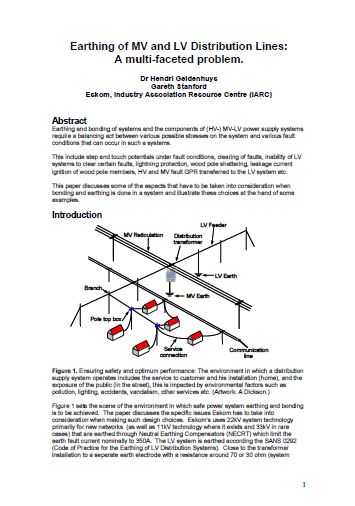Introduction
Figure 1 sets the scene of the environment in which safe power system earthing and bonding is to be achieved. The paper discusses the specific issues Eskom has to take into consideration when making such design choices. Eskom’s uses 22kV system technology primarily for new networks (as well as 11kV technology where it exists and 33kV in rare cases) that are earthed through Neutral Earthing Compensators (NECRT) which limit the earth fault current nominally to 350A.

The LV system is earthed according the SANS 0292 (Code of Practice for the Earthing of LV Distribution Systems).
Close to the transformer installation to a separate earth electrode with a resistance around 70 or 30 ohm (system voltage and protection dependant) aimed at clearing a MV system fault contact to the LV system by mean of the MV earth fault protection.
Power system safety and power system supply reliability
There is primarily personal and animal safety as well as system continuity of supply and system reliability considerations to be thought about when designing power system earthing.
Transferred Power Frequency potential from the MV system
In the case of open wire overhead MV systems (not cables) Eskom uses a neutral arrester to separate the MV earth from the LV earth at a transformer.
This is done to isolate any ground potential rise (GPR) voltage emanating from the MV network to the LV earth system, as this will be transferred directly to the customers on the LV feeders if there is a direct connection between the MV and LV earth. The MV GPR voltages can be a few kV and would be lethal if it occurred wile a customer was touching the power safety earth and the local ground at the same time.
This paper focuses on considerations on achieving an optimally safe and (power system) optimal reliable bonding and earthing of a wood pole structure that carries MV, LV and other services at the same time.
| Title: | Earthing of MV and LV Distribution Lines: A multi-faceted problem – Dr Hendri Geldenhuys, Gareth Stanford |
| Format: | |
| Size: | 349.5 KB |
| Pages: | 9 |
| Download: | Right here | Video Courses | Membership | Download Updates |


